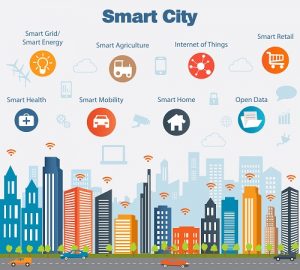Issue Briefs

Towards Smart Cities
Murat Kuzlu
August 3, 2016
For many decades cities have been playing a key role in human progress and development. Right now, more than of the world’s population is urban. Most people live, work and conduct many other activities from dining, to sports, to entertainment and recreation in cities. It is expected that this percentage will rise to 70% by 2050.
The rapid transition to an urbanized world population has forced societies and their elected leaders to focus on how to properly meet specific requirements of urban life such as public safety, efficient resource utilization, energy conservation, traffic control, telemedicine, and efficient delivery of public services to millions of users.
The smart city
The smart city concept can be the solution to these challenges caused by so many people with varying needs sharing an urban space. A smart city is a complex network of interconnected systems, encompassing transportation, education, healthcare, e-governance, public security, energy and others. These systems are connected together by information and communications technologies (ICT) which transmit and process data [1]. A smart city provides real time and remote monitoring for different aspects of data management throughout the city. See Fig.1.
Better use of scarce resources
The main purpose of the smart cities is to facilitate higher levels of economic growth and improve the quality of life of people by using advanced communication and computing technologies. Smart applications will enable cities to use technology, information and data to improve the quality of infrastructure and services. In addition, these applications will contribute to improve quality of life, create employment and increase income [2].

Fig. 1. The smart city concept [3].
The smart energy/smart grid domain is one of key components of the smart city concept. The building blocks of a smart city are powered by a smart grid. A smart grid is the next generation electrical system that allows for two-way communications between the utility and its customers. It enables advanced applications, e.g., smart metering, pricing, demand response, renewable energy integration, electric vehicles operations, and more. See Figure 2.
A smart grid is an advanced grid system which can manage electricity demand in a sustainable, reliable, efficient and economic manner. It provides an opportunity to move the power generation and distribution sectors into a new era. This will contribute to the creation of sustainable, smart cities. A smart grid provides adequate levels of electricity in order to meet rising demand. It provides higher reliability and quality of power supply, it increases energy efficiency, and it enables the integration of renewable energy sources into existing power systems.
Efficiency
Additionally, a smart grid provides efficient control of energy production, generation, transmission, distribution and consumption to reduce peak demand, CO2 emissions and other pollutants. The consensus is that the smart grid is the future of an electrical system. This will play a crucial role in allowing smart cities to meet major electricity requirements in terms of capacity, reliability, efficiency and sustainability [4].
![Fig. 2. The smart grid concept [[5]]](https://globalpi.org/wp-content/uploads/2016/08/smartgridconcept2-1024x520.jpg)
Fig. 2. The smart grid concept [5]
According to the U.S. Energy Information Administration (EIA), 41% of all energy used in the U.S. is consumed in residential and commercial buildings. The International Energy Agency (IEA) estimates that buildings represent 32% of total final energy consumption all over the world.
Due to such high levels of energy consumption, buildings are also one of the major contributors to greenhouse gas production. As major energy consumers buildings also offer many opportunities to achieve significant energy savings, and therefore also significant greenhouse gas emission reductions.
Make buildings efficient
Buildings are key elements of all aspects of urban living. People who live in cities spend most of their time in buildings. With the integration of ICT and sensor technologies, buildings will become complex entities, i.e., smart buildings, with multiple interconnected systems such as lighting, ventilation and cooling, and security. See Figure 3.
Building automation systems (BAS) play a key role in designing and operating smart buildings. BAS typically consist of building energy management systems (BEMSs), physical security and access control, and other systems (such as elevators, public announcements, and closed-circuit television). BEMS generally control heating, ventilation, and air conditioning (HVAC), lighting systems and plug loads and can interact with smart grid applications such as demand response, pricing, etc. [6]. BEMSs are also very important because they allow smart buildings to minimize energy consumption while maintaining customers’ comfort.
Improve the use of energy
Fortunately, with advancements in computational intelligence (CI) techniques, e.g., artificial neural networks (ANN), fuzzy logic, etc., and their integration to BEMSs, these techniques offer advanced solutions to achieve optimal energy efficiency, energy security, and customer comfort in smart buildings.
Implementing smart building solutions with (CI) techniques will allow modern buildings to be green, safe, and productive. It is estimated that the combination of these technologies will allow buildings to save up to 40 percent of energy usage, up to 30 percent of water usage, while reducing overall building maintenance costs by 10-30 percent [7].
![Fig. 3. The overview of a smart building [8]](https://globalpi.org/wp-content/uploads/2016/08/smartbuilding3.jpg)
Fig. 3. The overview of a smart building [8]
Our urban future
The smart city model is made up of various integrated key sectors such as transportation, education, healthcare, e-governance, public security, and energy.
The smart energy/smart grid is one of most important components of the smart city model. It will become a key tool to allow the achievement of sustainability because it will enhance an efficient and cost-effective use of resources.
Various models indicate that advanced smart grid applications and a computational intelligence based BEMS architecture will make an important contribution in the creation of sustainable cities by enhancing energy efficiency, energy savings, and peak use reduction.
Murat Kuzlu, PhD is a GPI Fellow and Assistant Professor of Electrical Engineering at Virginia Tech Advanced Research Institute. His research interests include smart grid, demand response, smart metering systems (AMR, AMI, AMM), home and building energy management system, co-simulation, wireless communication and embedded systems.
References
[1] The Smart/Connected City and Its Implications for Connected Transportation, http://www.its.dot.gov/itspac/Dec2014/Smart_Connected_City_FINAL_111314.pdf . Retrieved on June, 2016.
[2] What is Smart City, http://smartcities.gov.in/writereaddata/What%20is%20Smart%20City.pdf. Retrieved on June, 2016.
[3] Smart city concept and internet of things, https://www.dreamstime.com. Retrieved on June, 2016.
[4] What is Smart Grid?, http://new.abb.com/smartgrids/what-is-a-smart-grid. Retrieved on June, 2016.
[5] What is Smart Grid?, http://www.naonworks.com/inc_html/sub2_3.html. Retrieved on June, 2016.
[6] M. Manic, D. Wijayasekara, K. Amarasinghe and J. J. Rodriguez-Andina, “Building Energy Management Systems: The Age of Intelligent and Adaptive Buildings,” in IEEE Industrial Electronics Magazine, vol. 10, no. 1, pp. 25-39, Spring 2016.
[7] Energy Ensemble (2015), http://energyensemble.com/news_details.php? news_id=240. Retrieved on June, 2016.
[8] Smart Buildings & Power Saving Solutions, http://takamulsystems.com/